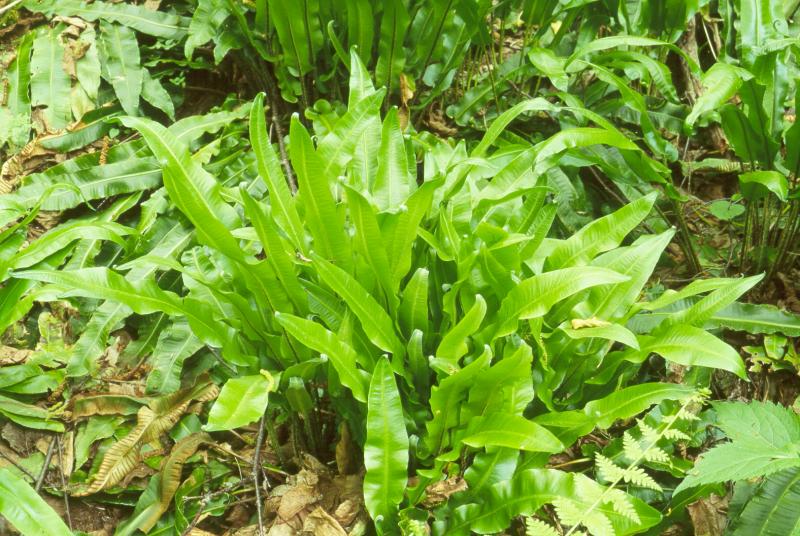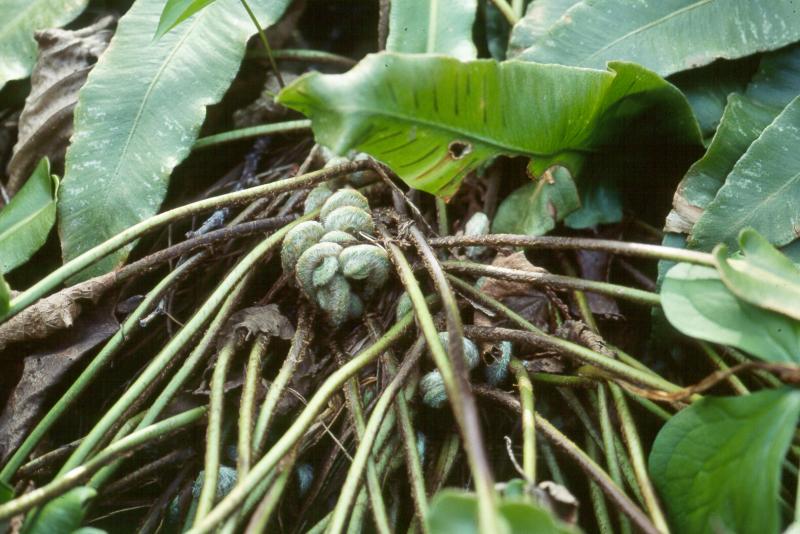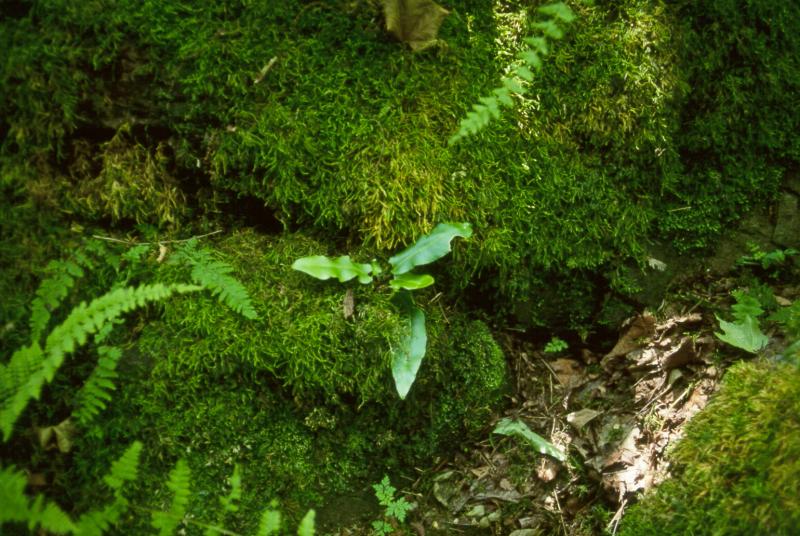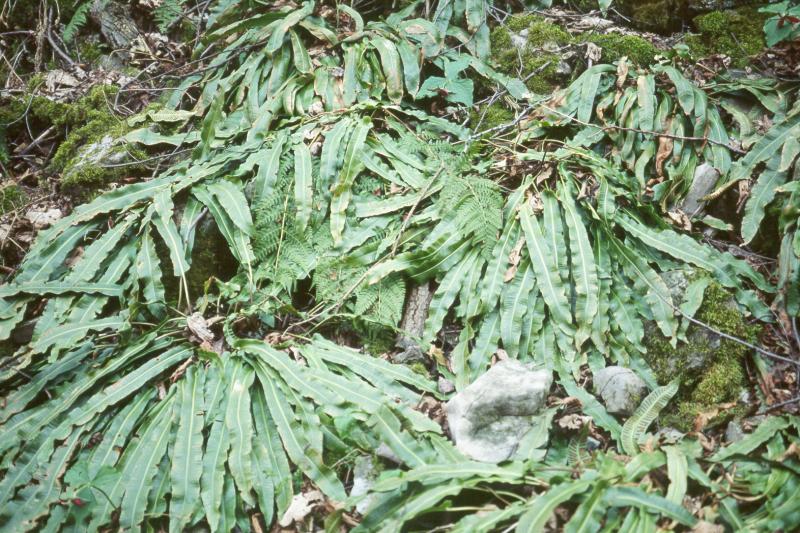Hart's-tongue Fern
Asplenium scolopendrium var. americanum (Fern.) Kartesz & Gandhi
- Class
- Filicopsida (Ferns)
- Family
- Aspleniaceae (Spleenwort Family)
- State Protection
- Threatened
Listed as Threatened by New York State: likely to become Endangered in the foreseeable future. For animals, taking, importation, transportation, or possession is prohibited, except under license or permit. For plants, removal or damage without the consent of the landowner is prohibited.
- Federal Protection
- Threatened
Listed as Threatened under the Federal Endangered Species Act
- State Conservation Status Rank
- S1
Critically Imperiled in New York - Especially vulnerable to disappearing from New York due to extreme rarity or other factors; typically 5 or fewer populations or locations in New York, very few individuals, very restricted range, very few remaining acres (or miles of stream), and/or very steep declines.
- Global Conservation Status Rank
- G4T3
Vulnerable globally - The subspecies/variety is at moderate risk of extinction due to rarity or other factors; typically 80 or fewer populations or locations in the world, few individuals, restricted range, few remaining acres (or miles of stream), and/or recent and widespread declines. (The species as a whole is apparently secure globally.)
Summary
Did you know?
The American Hart's-tongue fern is listed by the US Fish & Wildlife Service as federally threatened. This is one of only a handful of New York plants protected under the Endangered Species Act. Approximately 90% of the known plants in the US are found right here in New York.
State Ranking Justification
There are fewer than twenty populations or sub-populations of this federally threatened species in New York. These populations are restricted to the Syracuse area. Most of the populations are currently threatened by various invasive species, but in particular, swallow-wort is a serious problem.
Short-term Trends
Since the legal protection of this species was put in place, the number of populations in New York has remained stable. Within these populations there may be a slight decrease in numbers of individuals due to competition from invasives. At this time, this decrease appears to be negligible, but as these invasive species continue to spread, their impact is likely to be more evident.
Long-term Trends
Prior to protection, a number of large populations were lost. These were mainly impacted by mining operations. Today, new mining operations are not likely in areas where this fern is known.
Conservation and Management
Threats
The most significant threat is swallow-wort (Cynanchum rossicum) and other invasive species. In the past, mining operations were a threat but new mines are not likely in areas where this plant is known.
Conservation Strategies and Management Practices
If population sizes are to be maintained, more effort is needed to reduce the impact of invasive species. Swallow-wort (Cynanchum rossicum) removal should be a priority management activity, especially if this is just becoming a problem within a population.
Research Needs
Taxonomy research needs to compare whether any distinction is warranted between the European and American varieties. If these varieties are warranted, then research is needed to determine if all of the New York populations are indeed the American variety. Based on morphology, some of the New York populations key out to the European variety.
Habitat
Habitat
This fern is typically found in glacial plunge basins on dolomite and other calcareous rocks. These basins typically have a high number of bryophyte species and are often cooler and moister than the surrounding upland areas. The ferns are often found on unstable talus or rock crevices below the basin cliffs (New York Natural Heritage Program 1999). On calcareous rocks in sinkholes, at cave entrances, and on cool, moist talus, always in deep shade (Flora of North America 1993). On limestone rocks and in sink-holes (Gleason and Cronquist 1991). Crevices and cool slopes or sink-holes of dolomite and other calcareous rocks (Fernald 1970).
Associated Ecological Communities
- Calcareous cliff community
(guide)
A community that occurs on vertical exposures of resistant, calcareous bedrock (such as limestone or dolomite) or consolidated material; these cliffs often include ledges and small areas of talus.
- Calcareous talus slope woodland
(guide)
An open or closed canopy community that occurs on talus slopes composed of calcareous bedrock such as limestone or dolomite. The soils are usually moist and loamy; there may be numerous rock outcrops.
- Hemlock-northern hardwood forest
(guide)
A mixed forest that typically occurs on middle to lower slopes of ravines, on cool, mid-elevation slopes, and on moist, well-drained sites at the margins of swamps. Eastern hemlock is present and is often the most abundant tree in the forest.
- Limestone woodland
(guide)
A woodland that occurs on shallow soils over limestone bedrock in non-alvar settings, and usually includes numerous rock outcrops. There are usually several codominant trees, although one species may become dominant in any one stand.
- Maple-basswood rich mesic forest
(guide)
A species rich hardwood forest that typically occurs on well-drained, moist soils of circumneutral pH. Rich herbs are predominant in the ground layer and are usually correlated with calcareous bedrock, although bedrock does not have to be exposed. The dominant trees are sugar maple, basswood, and white ash.
Associated Species
- Acer nigrum (black maple)
- Acer rubrum var. rubrum (common red maple)
- Acer saccharum (sugar maple)
- Acer spicatum (mountain maple)
- Aralia nudicaulis (wild sarsaparilla)
- Asarum canadense (wild ginger)
- Asplenium rhizophyllum (walking fern)
- Asplenium trichomanes
- Athyrium filix-femina
- Betula alleghaniensis (yellow birch)
- Caulophyllum thalictroides (blue cohosh, late blue cohosh)
- Celtis occidentalis (northern hackberry)
- Cystopteris bulbifera (bulblet fern)
- Deparia acrostichoides (silvery spleenwort)
- Diplazium pycnocarpon
- Dryopteris goldiana (Goldie's wood fern)
- Dryopteris intermedia (evergreen wood fern, fancy wood fern, common wood fern)
- Dryopteris marginalis (marginal wood fern)
- Epipactis helleborine (helleborine, weed orchid)
- Eupatorium rugosum
- Geranium robertianum (herb-Robert)
- Hepatica nobilis var. obtusa
- Hesperis matronalis (dame's rocket)
- Impatiens capensis (spotted jewelweed, spotted touch-me-not)
- Impatiens pallida (pale jewelweed, pale touch-me-not)
- Osmorhiza claytonii (bland sweet-cicely)
- Osmorhiza longistylis (aniseroot, long-styled sweet-cicely)
- Ostrya virginiana (hop hornbeam, ironwood)
- Polypodium virginianum (Virginian rock polypody, Virginian polypody)
- Solidago flexicaulis (zig-zag goldenrod)
- Staphylea trifolia (bladdernut)
- Taxus canadensis (Canada yew, American yew)
- Thuja occidentalis (northern white cedar, arbor vitae)
- Tilia americana var. americana (American basswood)
- Tsuga canadensis (eastern hemlock)
- Tussilago farfara (colts-foot)
Range
New York State Distribution
Native populations of this fern are restricted to glacial plunge basins in the Syracuse area. Records indicate that wild plantings have been made in various areas of the state. The status of these plantings is not currently known.
Global Distribution
This fern occurs disjunctly, restricted to localized populations in New York, Michigan, Ontario, Tennessee, and Alabama. At present, the species is extant in seven counties in the province of Ontario, two counties in New York, two counties in Alabama, two in Michigan and one county in Tennessee (USFWS 1989a). A population introduced from a rescue activity in New York in the 1930's still thrives in New Jersey and likley in other areas of New York.
Identification Comments
General Description
Hart's-tongue fern is a perennial, evergreen fern growing from a shortish, stout, ascending caudex-like rhizome. Fronds are 5-17 inches (10-34 cm) long and auriculate at the base.
Identifying Characteristics
This fern typically has fronds that are 10-34 (average 23) cm long. Sori on the fertile fronds are usually limited to the upper half of the frond. The longer indusia are narrowly oblong, 0.3-2.2 (average 1.2) cm long. The scales of the stipe are all narrow and with tips that curl.
Best Life Stage for Proper Identification
This fern may be identified at any point in the year, as long as snow cover does not bury the plants. Based on its unique features, only the leaf frond is needed for proper identification. Due to its rare nature and federal protection, DO NOT COLLECT. A photo may be used to verify the identification.
Similar Species
The European variety (var. scolopendrium) is a larger more robust plant with sori present from the frond tip to more than halfway beyond the frond middle. The fronds are 10-60 (average 30) cm long, with the fruiting portion of the fertile fronds occupying one-third to the full length (average 73%) of the frond. The longest indusia of each frond are linear, 0.17-3.3 (average 1.7) cm long. The stipes have lance-shaped scales that gradually taper to a slender tip. These scales are of mixed widths.
Best Time to See
This unique fern may be identified at any point during the year, as long as the leaves are not covered by snow. If you are trying to find new populations, the best time is in mid-fall after a few frosts have eliminated most other herbaceous plants and before too much snow accumulates. Early spring after the snow melts and before most herbaceous plants reappear is also a good time.
- Vegetative
- Fruiting
The time of year you would expect to find Hart's-tongue Fern vegetative and fruiting in New York.
Hart's-tongue Fern Images
Taxonomy
Hart's-tongue Fern
Asplenium scolopendrium var. americanum (Fern.) Kartesz & Gandhi
- Kingdom Plantae
- Phylum Filicinophyta
- Class Filicopsida
(Ferns)
- Order Filicales
- Family Aspleniaceae (Spleenwort Family)
- Order Filicales
- Class Filicopsida
(Ferns)
- Phylum Filicinophyta
Additional Common Names
- American Hart's-tongue
- American Hart's-tongue Fern
Synonyms
- Phyllitis scolopendrium (L.) Newman
- Phyllitis scolopendrium var. americana Fern.
- Phyllitis scolopendrium var. americanum Fern.
- Scolopendrium vulgare Small
Additional Resources
Best Identification Reference
Flora of North America Editorial Committee. 1993. Flora of North America, North of Mexico. Volume 2. Pteridophytes and Gymnosperms. Oxford University Press, New York. 475 pp.
Other References
Cinquemani Kuehn, D.M., and D.J. Leopold. 1992. Long-term demography of Phyllitis scolopendrium (L.) Newm. var. americana Fern. in central New York. Bulletin Torrey Botanical Club 119(1): 65-76.
Cinquemani Kuehn, D.M., and D.J. Leopold. 1993. Habitat characteristics associated with Phyllitis scolopendrium (L.) Newm. var. americana Fern. (Aspleniaceae) in central New York. Bulletin Torrey Botanical Club 120(3): 310-318.
Cinquemani Kuehn, Diane M. 1989. Demographic and habitat studies of Phyllitis scolopendrium (L.) Newm. var. americana Fern. in central New York State. Masters Thesis. State University of New York College of Environmental Science and Forestry, Syracuse, NY 73 pp.
Cinquemani, D.M., M.E. Faust, and D.J. Leopold. 1988. Periodic censuses (1919-1986) of Phyllitis scolopendrium var. americana in central New York state. American Fern Journal 78(2): 37-43.
Clovis, J.F. 1954. The hart's tongue?An interesting fern. Castanea 19(2): 75-78.
Fernald, M.L. 1950. Gray's manual of botany. 8th edition. D. Van Nostrand, New York. 1632 pp.
Futyma, R.P. 1980. The distribution and ecology of Phyllitis scolopendrium in Michigan. American Fern J. 70(3): 81-87.
Gleason, Henry A. and A. Cronquist. 1991. Manual of Vascular Plants of Northeastern United States and Adjacent Canada. The New York Botanical Garden, Bronx, New York. 910 pp.
Holmgren, Noel. 1998. The Illustrated Companion to Gleason and Cronquist's Manual. Illustrations of the Vascular Plants of Northeastern United States and Adjacent Canada. The New York Botanical Garden, Bronx, New York.
House, H.D. 1934. Saving the scolopendrium fern. American Fern Journal 24(3): 65-71.
Hunter, M.R. 1934. Notes on Scolopendrium vulgares Sm. American Fern Journal 14: 102-104.
Hunter, Mable R. 1922. The present status of Scolopendrium in New York State. American Fern Journal 9:28-36.
McColl, W.R. 1925. Data on Scolopendrium vulgare J.E. Smith. American Fern Journal 15(1): 90-93.
New York Natural Heritage Program. 2010. Biotics database. New York Natural Heritage Program. New York State Department of Environmental Conservation. Albany, NY.
New York Natural Heritage Program. 2024. New York Natural Heritage Program Databases. Albany, NY.
Reschke, Carol. 1990. Ecological communities of New York State. New York Natural Heritage Program, New York State Department of Environmental Conservation. Latham, NY. 96 pp. plus xi.
U.S. Fish and Wildlife Service (USFWS). 1989b. Final rule: Threatened status for Phyllitis scolopendrium var. americana. Federal Register 54(134): 29726-29730.
Weldy, T. and D. Werier. 2010. New York flora atlas. [S.M. Landry, K.N. Campbell, and L.D. Mabe (original application development), Florida Center for Community Design and Research http://www.fccdr.usf.edu/. University of South Florida http://www.usf.edu/]. New York Flora Association http://newyork.plantatlas.usf.edu/, Albany, New York
Links
About This Guide
Information for this guide was last updated on: March 2, 2005
Please cite this page as:
New York Natural Heritage Program. 2024.
Online Conservation Guide for
Asplenium scolopendrium var. americanum.
Available from: https://guides.nynhp.org/harts-tongue-fern/.
Accessed April 16, 2024.



